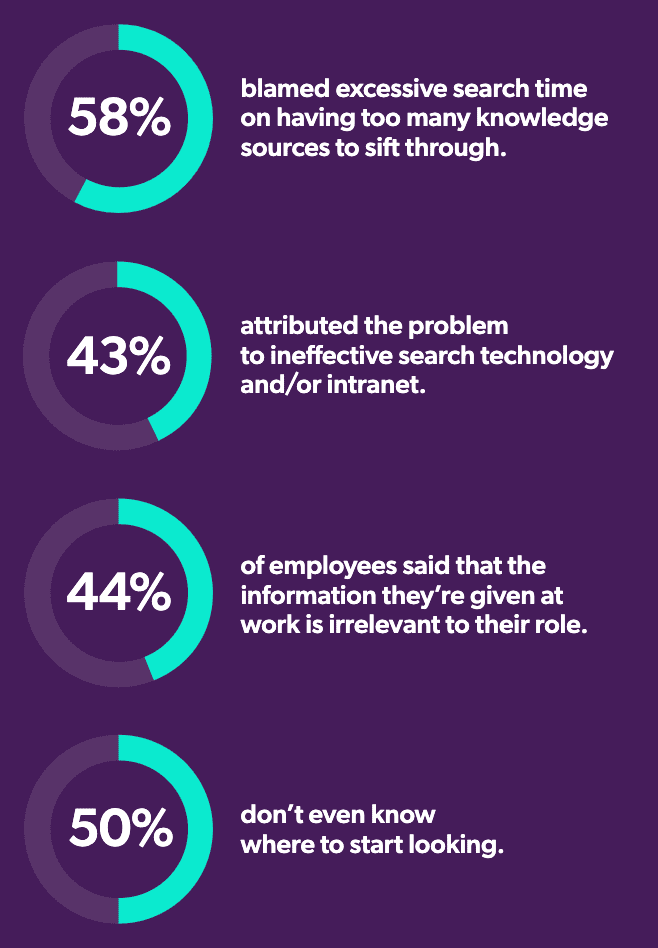While the Great Resignation may be slowing, employees are still moving to greener pastures at record-setting rates. With a turnover rate of 18.6 percent, Business and Finance is one of the hardest hit industries. So now the question is: what can organizations do to retain their talent? The short answer: provide them a good digital employee experience optimized for the flexible work and work from home environments that are here to stay.
Level up with AI
Employees are wasting almost a third (30 percent) of their work day because they can’t find the information they need, leading to frustration and burnout. Where does this problem stem from?
The solution? Make a one-stop, trusted knowledge hub where employees have streamlined access to the information they need. By consolidating resources into a single platform, companies can save their employees from continuously switching between applications and data sources just to find the right tools and relevant information to do their job. F&I companies can level up by adding AI-powered search to their IT systems, improving search performance further.
With AI technology, employees can get personalized recommendations and information within their flow of work. And, in turn, a more intuitive workflow boosts employee proficiency and satisfaction. AI adoption overall reduces employee workload by 25 percent and operational costs by 34 percent in North America, saving both time and money.

Insurance company Manulife improved employee search experiences by implementing AI into their global intranet – specifically, by supporting employees with finding role-specific and task-specific information in addition to general company information and news.
By analyzing employee search data across both internal and external applications, AI could then leverage the insights to create personalized results based on search terms and other key indicators. And, with machine learning models, these suggestions can be automatically updated and enhanced over time.
Manulife saw more than 70 percent of their intranet searches guided by AI-driven recommendations and earned an average click rank score of 2.1 – meaning, employees were finding what they needed within the first two items in the search results list.
Build lasting employee engagement
It costs up to two times an employee’s annual salary to hire a replacement if they leave. What does that look like in a 100,000-person organization providing an average salary of $50,000? A yearly loss of $600 million to $2.6 billion due to turnover and replacement costs.
Considering these points, keeping employees happy and motivated is essential to the bottom line. And unhappy employees usually start with feeling unengaged with their work.

One area is information overload – there’s simply too many sources and tools to sift through to get to the relevant information. Employees often must search within four or more data sources to find the critical information they need. This pain point is compounded by bad search technology, with nearly half (43 percent) of employees finding fault with ineffective search tech and/or intranet. Many banks and insurance companies are still reliant on decades-old legacy systems, further limiting employee efficiency.
Only 32 percent of U.S. employees are engaged during work, which feeds a downward spiral in productivity and ultimately causes serious business challenges. With employees feeling stifled and disengaged from their work, what can businesses do to reverse this trend?
Companies need digital transformation – that is, upskilling employees with new technologies and innovation. A digitally savvy workforce is a must for success in an increasingly digital-first world, accelerated by the pandemic. And yet a global survey found only a third of employees are getting the resources and training they need to keep pace with the digital skills their jobs require.
Companies that implement skilling initiatives are more attractive to job seekers and current employees. Employees who receive digital skills training are more engaged at work (70 percent) and are more likely to stay in their jobs (66 percent).
When offering training to employees, it’s important to optimize learning for a remote workforce or deskless employees. Most employees still prefer work from home and 73 percent prefer to learn on the job as opposed to formal training in the office. By making it easier to find the information an employee needs when they need it, you can fill knowledge gaps created by a lack of training or ineffective training.
By using AI-powered tools, companies can replace arcane, inefficient processes with intuitive, personalized workflows that help employees learn critical digital skills as they work. They are on the front lines with advanced technologies that can deliver real-time guidance to them as they do their jobs.
Modern platforms put building digital skills front and center for employees, keeping them engaged, motivated and invested in their company’s innovation. And that employee commitment is key for businesses looking to stand out in the competitive financial market.
Create customer-centric cultures and career opportunities
Once employees have the relevant information, tools and training at hand, they can focus on higher level problems such as providing better customer service, as well as develop in their careers.
Let’s take a customer service agent as an example. Digital transformation can help build better customer relationships by giving agents access to real-time personalized information based on insights into each individual customer’s journey. Agents have real-time, specific information on hand when a customer reaches out, enabling them to pinpoint solutions quickly and leave the customer with a seamless experience.
AI can also improve case submission flows by matching cases to the right agents for resolving the issue. This leads to reduced waiting times and personalized support for customers in another way to boost their satisfaction and trust in the company.
In a positive feedback loop, empowering employees to provide great customer service bolsters customer loyalty and drives incremental business, which in turn generates revenue that can then be re-invested in your employees. With the right technology tools, companies can grow their employees and their business. In a service-centric industry like F&I, employees are high value assets. F&I organizations need to give them tools and training that allow them to be proficient, technologically-savvy and feel accomplished.












